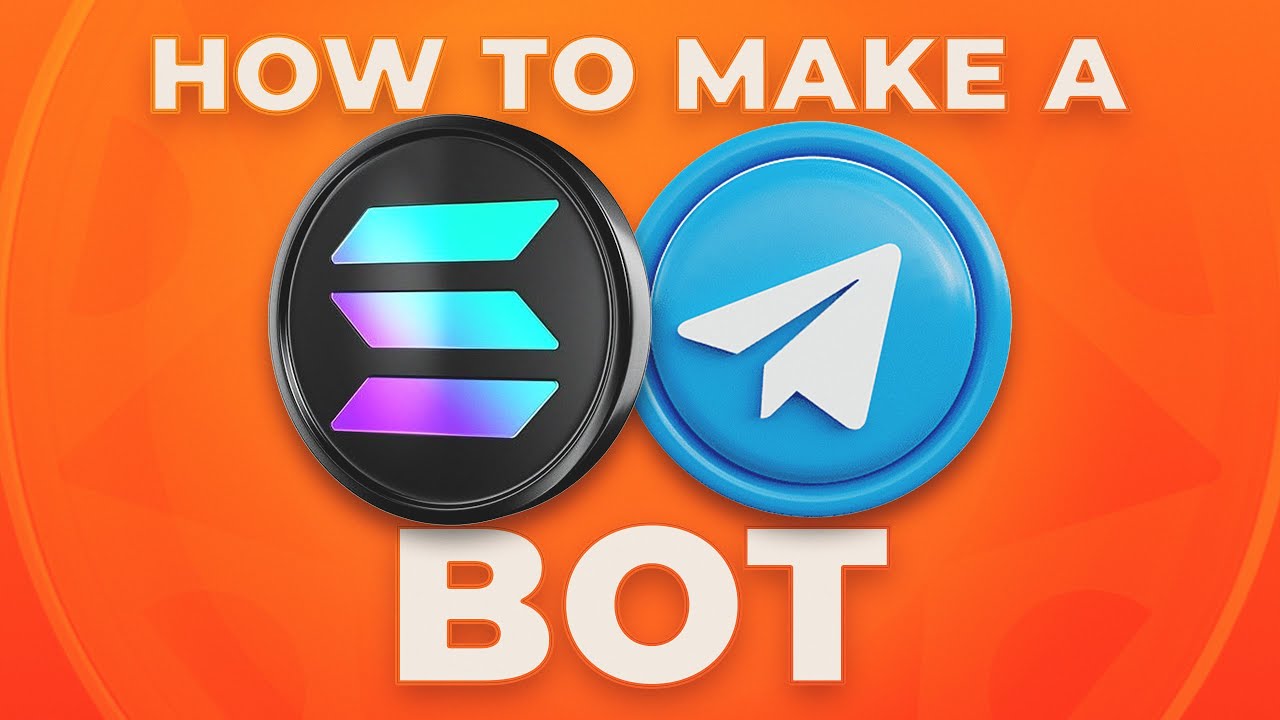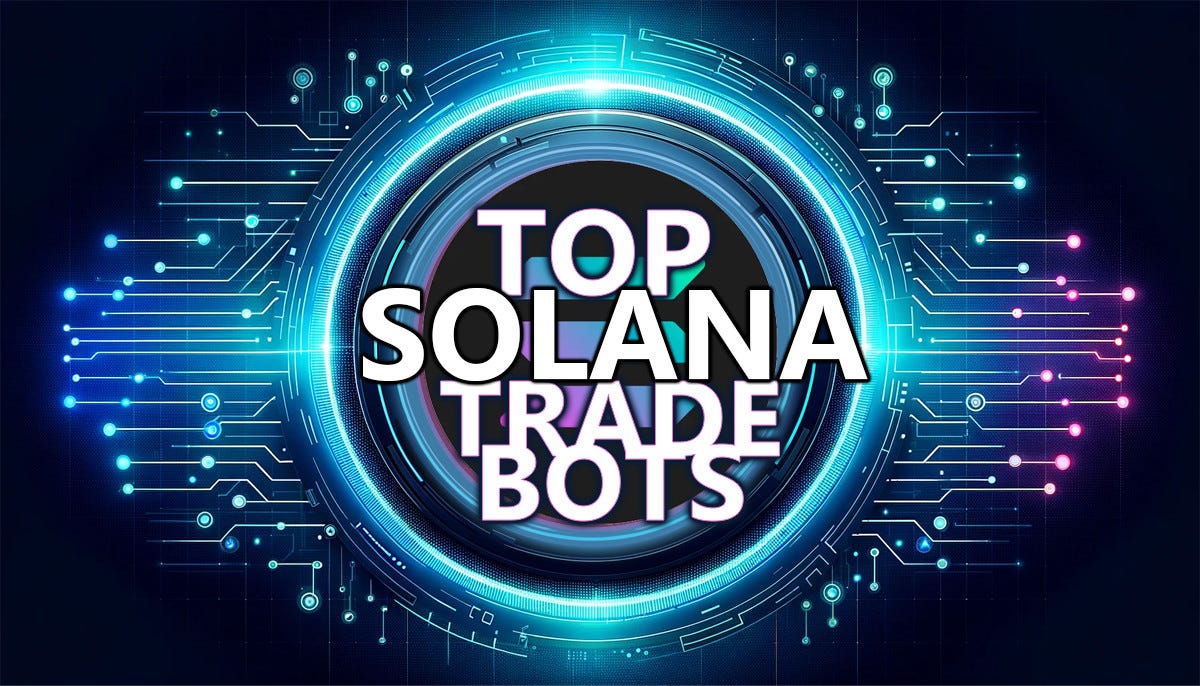How to Build a Solana Trading Bot for Beginners 2025
 Denwigwe Blossom
Denwigwe BlossomHow to Build a Solana Trading Bot for Beginners 2025

How to Build a Solana trading bot in 2024, or a telegram bot for Solana trading, is easier than you think. All you need to get started is a laptop, an internet connection, and the necessary skill set. Building your trading bot has a lot of advantages, as it allows you to automate your trading strategies, increase profits, avoid mistakes, and reduce the stress of manual trading.
As a beginner, the first thing you must achieve is understanding how the Solana ecosystem works, including the various available platforms and the blockchain network. After which, choose a programming language compatible with the Solana blockchain and set up the framework for developing your Solana trading bot.
Getting Started with Solana and Trading Bots
Before diving into coding, it’s important to understand Solana’s ecosystem—its blockchain, the tools available for building bots, and the best trading platforms. Solana is known for its speed and low fees, making it an ideal blockchain for automated trading.
Next, choose a programming language and framework that fits your needs. Rust is a great choice because it’s built for performance and works seamlessly with Solana. If you’re looking for something more beginner-friendly, Python is popular due to its ease of use and vast library support.
Once your development environment is ready, you can start writing your bot. Key features to implement include data collection, analysis, and trade execution. Before you start trading with real money, be sure to test your bot with historical data or in a simulation environment.
Finally, remember that cryptocurrency markets are volatile. Continuously monitoring and fine-tuning your bot will help ensure its long-term success.
What Are Solana Trading Bots?

Solana trading bots are automated programs that buy and sell assets on the Solana blockchain based on predefined strategies, such as arbitrage, trend-following, or market-making. These bots execute trades automatically, saving you time and potentially making smarter, faster decisions. Solana’s speed and low transaction costs make it an excellent platform for bots.
To use a trading bot, you’ll typically connect it to a Solana-compatible exchange via an API key. From there, you can set parameters such as which assets to trade, how much to buy or sell, and your risk management rules. Once set, the bot will monitor the market and execute trades according to your strategy. However, remember that trading bots come with risks, such as bugs in the code or sudden market changes that may lead to unexpected losses.
Why Use a Trading Bot for Solana?
There are several reasons why traders turn to bots when trading on Solana:
First on the list is automation. Bots follow predefined strategies without human intervention, improving efficiency.
Secondly, there is the speed involved, as bots can act much faster than humans, capitalizing on market movements before they pass.
We also have the 24/7 Operation advantage since bots can trade around the clock, taking advantage of opportunities in different time zones.
Again, there is the back-testing and optimization option. Bots can be tested with historical data to refine strategies and improve performance.
Bots seem to have emotional Discipline, which almost all traders lack. Bots trade based on logic and rules, eliminating emotional decisions that can lead to mistakes.
Diversification techniques make them better traders as they can manage multiple strategies and assets simultaneously, helping diversify risk.
Finally, risk management features like stop-loss orders can help minimize losses during unpredictable market conditions.
A trading bot can streamline your trading process and enhance your performance.
Business Benefits of Solana Trading Bot Development
For businesses, developing a Solana trading bot offers significant advantages:
Increased Efficiency: Automating trades reduces the need for manual input and increases overall productivity.
Cost Savings: Bots can lower operational costs by removing human labor and reducing the chance of errors.
Faster Execution: Bots can execute trades at lightning speed, seizing opportunities humans might miss.
Scalability: Bots can handle many trades simultaneously, enabling businesses to scale their operations.
Data-Driven Decisions: Bots analyze vast amounts of trading data quickly, offering valuable insights for decision-making.
Risk management: Bots can manage risk, reducing the likelihood of large losses during trades.
Developing a Solana trading bot can help businesses boost efficiency and improve their trading results, especially in the fast-moving cryptocurrency market.
Top 5 Solana Trading Bots in 2024
Here are five well-regarded Solana trading bots that you might want to consider in 2024:
1. Hummingbot: Open-source and highly customizable, Hummingbot supports Solana and other cryptocurrencies. It’s perfect for market-making and arbitrage strategies.
2. 3Commas: Known for its user-friendly interface, 3Commas offers a variety of bots with advanced features like trailing stop-loss and take-profit.
3. Bitsgap: A versatile platform that supports Solana, Bitsgap provides automated trading, portfolio management, and arbitrage features.
4. Cryptohopper: A cloud-based solution that integrates with Solana, Cryptohopper offers backtesting, trailing stop-loss, and a marketplace for buying and selling strategies.
5. Kryll.io: This platform lets users design and deploy their trading strategies using a visual editor. It’s ideal for those who want to experiment with different approaches.
Bot effectiveness varies, so test them thoroughly before committing real funds.
Steps to Build a Solana Trading Bot

Building your own Solana trading bot involves several key steps:
1. Define Your Strategy: Decide your trading approach (e.g., arbitrage, trend following). Determine factors like entry/exit points and risk management rules.
2. Choose Your Tools: Select programming languages and frameworks. Solana works well with Rust and C, but Python is another option.
3. Access the Solana Blockchain: Set up your development environment to interact with Solana using the Solana API or SDKs.
4. Develop Trading Logic: Write the code that tells your bot how to analyze market data, place orders, and manage risk.
5. Backtest: Test your bot using historical data to refine your strategy and ensure it performs as expected.
6. Connect to Exchanges: Integrate your bot with an exchange that supports Solana trading, ensuring it can execute real-time trades.
7. Risk Management: Implement stop-loss and other protective measures to reduce exposure to significant losses.
8. Monitor & Optimize: Monitor your bot’s performance and adjust to improve results.
9. Security: Follow best practices for software development to secure your bot from potential risks like hacking.
10. Compliance: Ensure your bot meets all legal and regulatory requirements for cryptocurrency trading.
Building a trading bot requires a solid understanding of trading, programming, and Solana’s ecosystem. Be sure to thoroughly test your bot before deploying it in live trading.
Common Challenges and Solutions
When building or using Solana trading bots, some common challenges include:
Bug-Free Code: Trading bots rely heavily on accurate, error-free code. Thorough testing and regular updates can help catch bugs early.
Risk Exposure: Bots can sometimes execute trades too quickly, exposing you to risk. Use stop-loss orders and other risk management strategies to protect yourself.
Market Volatility: The crypto market is highly volatile. By tweaking parameters and optimizing algorithms, ensure your bot adapts to changing conditions. By being proactive about testing, security, and risk management, you can improve your bot's performance and profitability.
How to create a bot on the Solana blockchain

Creating a bot on the Solana blockchain might seem daunting at first, but let's break it down into simple, easy-to-understand steps. Imagine you're setting up a helpful assistant to manage some of your trading tasks on Solana. Here's how you can do it:
1. Getting Ready: The Prerequisites
Before your bot can come to life, you'll need a few things in place:
- Install Required Software Packages: Consider these as the tools your bot needs to interact with the Solana network and markets.
- @solana/web3.js: Allows your bot to communicate with the Solana blockchain.
- @project-serum/serum: It helps your bot interact with serum, which is a decentralized exchange on Solana.
- @solana/spl-token: Enables your bot to handle token transactions on Solana.
- A Solana Wallet with Some SOL Tokens: SOL is the native cryptocurrency of the Solana network. Your bot will need some SOL to pay transaction fees and execute trades. Setting up a wallet is like opening a bank account for your bot.
- Access to a Solana RPC Node: This gateway connects your bot to the Solana network. You can use public nodes available online or set up your own. It's similar to having an internet service provider for your bot.
2. Understanding What Your Bot Will Do
Your bot is going to be your tireless assistant in the crypto market, and here is what it will be capable of:
- Connect to the Solana Network and Specific Markets: It will establish a secure connection to Solana and focus on your interests.
- Get Real-Time Market Prices: The bot will fetch up-to-the-minute prices, so it always knows the current market situation.
- Place Buy and Sell Orders: Based on your instructions, it can automatically buy or sell tokens, saving you from manual trading.
- Monitor Your Wallet Balance: It keeps an eye on how much you have invested and what's available for trading.
- Handle Basic Errors: The bot can manage these hiccups without crashing if something doesn't work as expected (like network issues).
- Configure Trading Parameters: You can set rules for how the bot trades—like setting limits on prices or amounts—so it follows your preferred strategy.
3. Setting Up and Using Your Bot
Now, let's get your bot up and running:
- Specify the Market You Want to trade in:
- Every market (like trading pairs of different cryptocurrencies) on Solana has a unique address.
- You'll need to replace YOUR_MARKET_ADDRESS in your bot's code with the address of the market you're interested in, such as SOL/USDC.
- Add Your Wallet's Private Key:
- Your private key is like the password to your wallet.
- Inputting it into the bot allows it to execute trades on your behalf.
- Important: Keep this private key secure and never share it publicly.
- Set Your Buy/Sell Thresholds:
- Decide the prices at which you want the bot to buy or sell.
- For example, "Buy SOL when the price drops below $20" or "Sell SOL when the price goes above $30."
- Implement Your Trading Strategy in the Main Loop:
- The main loop is where the bot continuously checks the market and decides what actions to take.
- You can program specific strategies, like how frequently it checks prices or adjusts orders.
4. Keeping Things Safe: Security Notes
When dealing with real money, caution is key, so ensure your bot operates safely:
- Never Share Your Private Key:
- Your private key grants full access to your funds.
- Only input it into secure applications you control.
- Start with Small Amounts While Testing:
- When you're first running your bot, use small amounts of SOL.
- This minimizes risk while you're making sure everything works correctly.
- Consider Adding Rate Limiting:
- Rate limiting prevents the bot from making too many requests in a short time.
- It helps avoid overloading the network or drawing unwanted attention.
- Add Proper Logging and Monitoring:
- Set up logs so you can always see what your bot is doing.
- This makes it easier to troubleshoot issues and understand their behavior.
- Consider Adding Stop-Loss Mechanisms:
- A stop-loss automatically sells your assets if the price drops to a certain point.
- This helps limit potential losses in volatile markets.
How Much Does The Solana Trading Bot Cost

The cost of a Solana trading bot can vary widely depending on several factors, including whether you build it, purchase a pre-built bot, or subscribe to a trading bot service. Let's see the breakdown to help you understand the potential costs involved:
Building Your Own Solana Bot
You can create your trading bot if you have programming experience, especially with blockchain technologies and the Solana ecosystem. The costs associated include:
- Development Time: Your personal time investment is significant but doesn't require out-of-pocket expenses.
- Learning Resources: Access to tutorials, courses, or books if you're new to programming on Solana (optional but beneficial).
Infrastructure Costs:
- Computing Resources: If you run the bot on your computer, costs are minimal. However, for 24/7 operation, you might need a Virtual Private Server (VPS), which costs around $10 to $50 per month.
- Solana Wallet Funds: Transaction Fees: Solana has minimal transaction fees (fractions of a cent), but you need some SOL tokens in your wallet to cover these.
- Development Tools: Most development tools and libraries for Solana are open-source and free.
Estimated Cost: Minimal financial cost (approximately $10 to $50 per month for VPS), but requires substantial time investment.
Purchasing a Pre-Built Bot

Pre-built Solana trading bots are available from various developers and platforms. Costs vary based on features, support, and reputation.
- One-Time Purchase: Prices can range from $100 to $1,000 or more, depending on the sophistication of the bot.
- Subscription Models: Monthly fees ranging from $20 to $200+. Higher tiers may offer advanced features, priority support, or trading limits.
Estimated Cost: Between $100 and $1,000 for one-time purchases or $20 to $200+ monthly subscriptions.
3. Subscription-Based Trading Platforms
Some platforms offer cloud-based trading bots, eliminating the need to manage the software or infrastructure.
- Monthly Fees: Typically range from $30 to $300+ per month.
- Features: User-friendly interfaces, access to multiple trading strategies, backtesting capabilities, and customer support.
Estimated Cost: Between $30 and $300+ per month, depending on the plan and features.
4. Hiring a Developer or Development Team
You might consider hiring professionals if you require a custom solution but lack programming skills.
- Freelance Developers: Rates can range from $50 to $150+ per hour.
- Development Agencies: Project-based pricing can start from $5,000 and increase depending on complexity.
Estimated Cost: Typically $5,000 to $20,000+, depending on project scope and developer rates.
5. Additional Costs to Consider
- Exchange Fees: Trading fees imposed by the exchanges you interact with.
- Data Feeds/API Access: Some bots require paid subscriptions to premium data feeds or APIs.
- Maintenance and Updates: Ongoing costs for software updates are especially important in rapidly changing markets.
- Security Measures: Invest in security audits or advanced protective measures to safeguard your assets.
6. Security and Regulatory Compliance
- Security: Always ensure the bot comes from a reputable source. Be cautious of scams or malicious software.
- Regulations: Verify that automated trading complies with local laws and exchange policies. Some jurisdictions have specific regulations regarding automated trading systems.
Conclusion
Building a Solana trading bot in 2024 can be an exciting and profitable venture. Following the steps outlined in this guide, you can create a bot that automates your trading strategy and helps you navigate the fast-paced world of cryptocurrency. However, knowing the risks involved is important, including potential losses.
Approach bot development carefully, test thoroughly, and monitor your bot’s performance to ensure long-term success. With the right strategy and precautions, a Solana trading bot can become a powerful tool in your trading arsenal.